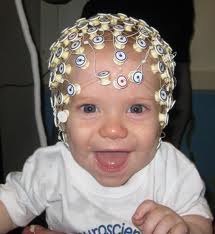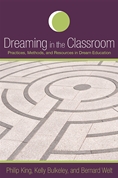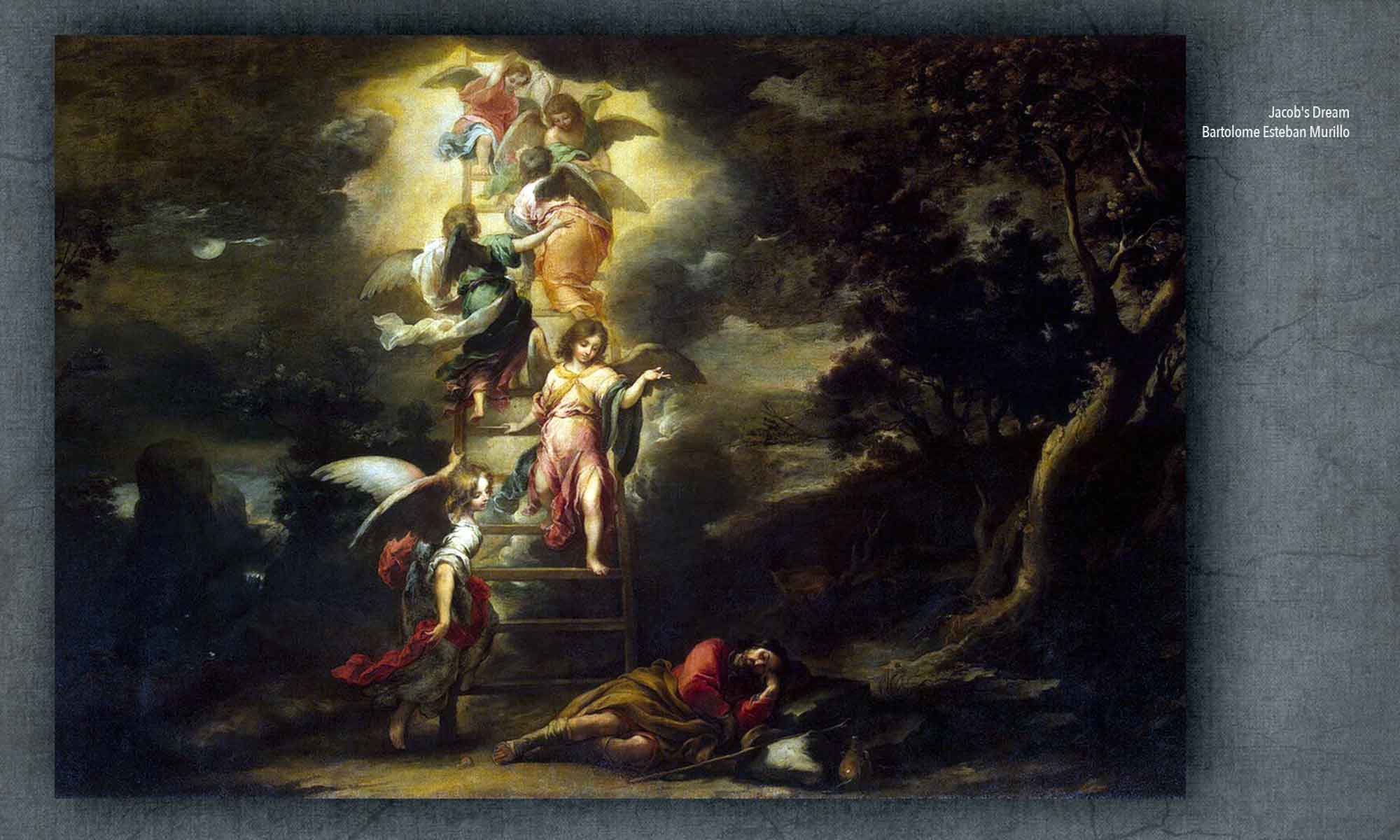 I recently received a copy of a new book by Fariba Bogzaran and Daniel Deslauriers, titled Integral Dreaming: A Holistic Approach to Dreams, just published by State University of New York Press. Fariba and Daniel are a wife-and-husband team who bring tremendous experience, knowledge, and creative insight to the study of dreams. I will write a longer review of the book in a future issue of DreamTime magazine. For now, I’ll just say that anyone who is interested in integral psychology in the lineage of Ken Wilber will certainly want to take a look at Bogzaran and Deslaurier’s work, which artfully combines phenomenological philosophy, scientific research, and practical dreamwork methodology.
I recently received a copy of a new book by Fariba Bogzaran and Daniel Deslauriers, titled Integral Dreaming: A Holistic Approach to Dreams, just published by State University of New York Press. Fariba and Daniel are a wife-and-husband team who bring tremendous experience, knowledge, and creative insight to the study of dreams. I will write a longer review of the book in a future issue of DreamTime magazine. For now, I’ll just say that anyone who is interested in integral psychology in the lineage of Ken Wilber will certainly want to take a look at Bogzaran and Deslaurier’s work, which artfully combines phenomenological philosophy, scientific research, and practical dreamwork methodology.
Cosmo Romance Dreams
 A couple of years ago a reporter from Cosmopolitan magazine sent me a list of dream types she had gathered from other women in her office. I can’t remember if an article ever appeared, but I thought the dreams were interesting as expressions of the concerns many women feel about their romantic relationships. Here is the intro I gave to the reporter, the dream types, and my comments. (Note: I just found a copy of the article. It appeared in the December 2010 issue, p. 112, under the rather lurid title “What Your Freaky Love Dreams Mean.”)
A couple of years ago a reporter from Cosmopolitan magazine sent me a list of dream types she had gathered from other women in her office. I can’t remember if an article ever appeared, but I thought the dreams were interesting as expressions of the concerns many women feel about their romantic relationships. Here is the intro I gave to the reporter, the dream types, and my comments. (Note: I just found a copy of the article. It appeared in the December 2010 issue, p. 112, under the rather lurid title “What Your Freaky Love Dreams Mean.”)
Many of these dreams seem to have a distressing, negative tone, so let me say that in general I look at “bad” dreams and nightmares as valuable opportunities for insight and growth. Such dreams usually revolve around the most emotionally important and challenging issues of our lives. They focus on our difficulties precisely in order to give us a deeper understanding of what’s going on and what we might do about it.
1) You’re back with an ex.
*Is there a different interpretation depending on whether the ex you dreamt about was a nice guy who you had a good relationship with vs. a bad guy who didn’t treat you well?
Dreaming about one’s past romantic partners never ends. He may be gone from your waking life, but, for better or worse, he’ll linger in your dreams forever. These kinds of dreams do NOT automatically mean you want to get back together with him. Rather, they reflect the complex and long-lasting impact any serious relationship makes on your unconscious mind. The details of the dream are important: I would want to know, in what situations does your ex appear? What kind of emotional energy does he bring into the dream scenario? If he’s a “good” ex, perhaps the dream suggests there’s still a way in which his presence is a helpful force in your waking life. If he’s a “bad” ex, maybe it reflects a sense of still being trapped in the relationship, or possibly threatened by something symbolized by his kind of personality.
2) Your partner betrays you in some way (like cheating, lying, or revealing something personal about you to everyone).
This is the price of a committed relationship: a vulnerability to betrayal. No matter how strong a relationship may appear in waking life, both people inevitably suffer some degree of insecurity, both conscious and unconscious, about their partner’s being unfaithful. This insecurity naturally comes out in dreams that vividly portray how badly you would feel if your partner violated your trust and fidelity. It’s possible the dreams are clues to an actual problem in the relationship (again, the details matter), but usually such anxiety dreams are reminders of our exposure to extreme emotional pain whenever we form a romantic bond with someone else.
3) You blow it with your man (whether by having a one-night stand, saying something cruel to him, etc.).
Monogamy doesn’t come easily. We all have within us complex and conflicting feelings about our romantic partners. It’s important to acknowledge and accept those feelings when they arise in dreams, even if we don’t necessarily act on them. That said, if someone were having these dreams frequently, I’d certainly wonder about the quality of their waking relationship.
4) You’re engaged, and there’s something off about your ring—the stone is missing or so small you can’t see it, it’s ugly, etc.
An engagement ring is an ancient emblem of love and commitment, a very public announcement of two people’s plans for a future life together. This makes it an excellent dream symbol for a person’s feelings about the impending marriage. Because the focus in these dreams is usually on the appearance of the ring, I’d want to ask if there’s a concern about the appearance vs. the substance of the relationship.
5) Something weird happens during your wedding (like you can’t see the groom’s face).
A wedding is one of the most momentous rituals of human society, a true rite of passage that forever binds two people’s lives into one. The awesome magnitude of this life change is often reflected in distressing dreams of wedding day disaster. A Buddhist perspective might be helpful here: In that tradition’s view, a dream of wedding catastrophe could be a good dream because it shows your old way of life is dying and a new and better way of life is being born. The weirdness reflects the shifting of your reality from the past to the future. In the case of the groom’s missing face, it might be that his appearance and personality are not the primary focus here; what’s ultimately important is the power of the vows you’re making with him.
Dystopian Dreaming
 While sitting in the audience and taking notes during the recent IASD conference in Berkeley, I found myself marking several instances where something the presenter said triggered my dystopian imagination. I confess to being a long-time fan of science fiction and fantasy stories about frightening future worlds controlled by alien invaders, zombie hordes, inhuman technologies, totalitarian governments, and/or rapacious capitalists (I made a list of some favorites below). I enjoy these stories as literary nightmares: vivid, emotionally intense simulations of real psycho-cultural threats, looming now and in our collective future.
While sitting in the audience and taking notes during the recent IASD conference in Berkeley, I found myself marking several instances where something the presenter said triggered my dystopian imagination. I confess to being a long-time fan of science fiction and fantasy stories about frightening future worlds controlled by alien invaders, zombie hordes, inhuman technologies, totalitarian governments, and/or rapacious capitalists (I made a list of some favorites below). I enjoy these stories as literary nightmares: vivid, emotionally intense simulations of real psycho-cultural threats, looming now and in our collective future.
At the IASD conference I realized I could turn this interpretive process inside out. I began to look at dream research from the genre perspective of dystopian fiction. What would an uber-villain in such stories find appealing in state-of-the-art dream research?
Let me be clear, these are my own shadowy speculations and in no way reflect anything directly said or intended by the presenters!
Sleep paralysis induction. There is now a proven technique for inducing the nightmarish experience of sleep paralysis–that is, causing someone to enter a condition in which their bodies are immobilized but their minds are “awake” and vulnerable to terrifying images, thoughts, and sensations. I can imagine this technique being put to nefarious use by military intelligence agents, state-controlled psychiatrists, and cybernetic overlords. The ability to trap a person within a state of sleep paralysis would be a horribly useful tool for anyone bent on total mind control.
Transcranial magnetic stimulation. This technology enables the direct manipulation of neural activity during REM sleep, targeting specific regions of the brain. If the technology were refined with malevolent purposes in mind, it could potentially disrupt people’s normal dreaming patterns, controlling what they do and don’t dream about. An evil scientist could thus invent a kind of anti-dream weapon, a magnetic beam aimed at the head of a sleeping person and programmed to stun, control, or destroy.
Disrupting PTSD memory formation. Trauma victims can diminish the symptoms of PTSD if they perform a series of distracting cognitive tasks with six hours of the trauma, thereby disrupting the formation of long-term traumatic memories. The future militarization of this method seems inevitable. Anything that alters memory can be used by evil governments to manipulate people against their will, either to do things they don’t want to do (black ops soldiers) or forget things that have been done to them (massacre survivors).
Remote monitoring of a person’s sleep. The Zeo sleep monitoring system (which I’ve used for three years) has now developed a wireless version that instantly relays the user’s sleep data from the headband via a bedside mobile phone to the Zeo database. This kind of technology opens the door to real-time remote monitoring of people’s sleeping experience, and potentially the ability to reverse the flow of data and influence/shape/guide people while they sleep. If enough people were linked into the system, it could serve police states as a valuable tool in 24-hour mind-body surveillance.
My interest in these morbidly malevolent scenarios is not entirely theoretical. Over the past few years of developing the Sleep and Dream Database I’ve been thinking of the darker possible applications of this technology, less Star Trek and more Blade Runner. If it’s true, as most researchers at the IASD are claiming, that dreams are accurate expressions of people’s deepest fears, desires, and motivations, then it’s also true a real potential exists to put that dream-based information to ill use.
Projecting even farther forward, I wonder if there might be some kind of future inflection point where the amount of data we gather suddenly reveals much bigger patterns and forms of intelligence than we had previously been able to recognize or scientifically document. What would happen if this leap of knowledge enabled our collective dreaming selves to somehow unite to challenge the dominance (one might say totalitarian regime) of waking consciousness?
I think about all this as I continue building up the SDDb, trying to make good decisions and avoid the nightmare pitfalls. Dystopian fantasies help me clarify what’s at stake, where the dangers lurk, and how the future may unfold.
You may be familiar with Arthur C. Clarke’s 1953 science fiction short story “The Nine Billion Names of God.” If so, you’ll understand why, as I work on developing new database technologies for dream research, I meditate on the phrase, “The Nine Billion Dreams of God.”
Dystopian Films and TV: Blade Runner, 12 Monkeys, Children of Men, Logan’s Run, The Matrix, Soylent Green, V for Vendetta, Battlestar Galactica, The Prisoner, Gattica, Terminator, Alien, Total Recall, 28 Days
Dystopian Novels: The Hunger Games, Fahrenheit 451, Neuromancer, 1984, Brave New World, The Time Machine
Dream Education = Religious Studies Education
 This is an excerpt from a panel on dream education at the recent conference of the International Association for the Study of Dreams. My co-panelists were Phil King and Bernard Welt, with whom I wrote Dreaming in the Classroom: Practices, Methods, and Resources in Dream Education.
This is an excerpt from a panel on dream education at the recent conference of the International Association for the Study of Dreams. My co-panelists were Phil King and Bernard Welt, with whom I wrote Dreaming in the Classroom: Practices, Methods, and Resources in Dream Education.
Any class on dreams that occurs within a school context must, at a minimum, provide educational benefits consistent with the school’s mission. These benefits usually include critical thinking, literacy skills, knowledge acquisition, global citizenship, etc. All of us on the panel agree that classes on dreams can do a wonderful job of providing these educational benefits and contributing to the general goals of almost any kind of school.
But dream classes can do more than that. Indeed, dream classes are always doing more than that, whether or not the teacher and students are explicitly aware of it. Something happens when dreams enter the classroom, something very different from other topics of study. Each of us on the panel has different ways of talking about that educational surplus. For me, what’s interesting is how every class on dreams becomes at some level a class on religious studies. By that I mean a class that studies human expressions of ultimacy via symbols, metaphors, and myths. The historical aspect of this may be most obvious. Prior to the rise of psychology as a Western academic discipline in the mid-nineteenth century, the primary arena in which people shared, discussed, and explored their dreams was religion–in Hinduism, Buddhism, Daoism, Judaism, Christianity, Islam, and the spiritual traditions of the indigenous peoples of Africa, the Americas, and Oceania. Any class that’s trying to provide a solid base of knowledge about dreams can’t ignore the history of religions. This is true whether you are teaching in psychology, literature, biology, or any other discipline—as soon as you start telling your students about dreams, you’ll need to talk about religious history, too.
I understand this might seem daunting to educators without any training or background in comparative religious studies. I’m not saying you have to include large amounts of this material in your curriculum. But I am saying you should think carefully about how you’re going to present the topics of your class within this bigger historical framework. You should let your students know there IS a bigger historical framework, even if that’s not the specific focus of your class.
There’s another way that dream classes become religious studies classes, even more important than the historical aspect. Whenever dreams become a topic of classroom discussion, the students are inevitably prompted to reflect on their private dream experiences. The class may not explicitly involve personal dream sharing, or keeping a journal, or anything directly about the students’ own dreams—but I guarantee you, the students are thinking about their dreams in relation to what’s coming up in the class. Especially if the teacher is a good one and gets the students excited about the topic, they’re going to be curious to explore their own dreams. And once they do that, they’re very likely to come across themes, questions, and experiences that go to the heart of many of the world’s religions—for example, the prospect of death and an afterlife, the struggle of good and evil, the illusory nature of reality, prophetic anticipations of the future, nightmarish suffering and existential dread, haunting encounters with supernatural beings, and so forth.
Teachers can ignore all this if they wish, but I think it’s better if they at least recognize that their students are wondering about these kinds of issues in their dreams and thinking about how the class is, or is not, helping them make better sense of their experiences. Again, this doesn’t mean you have to devote extensive class time to the religious implications of dreams in people’s lives. You could devote some time to this topic, of course, and I think you’d be surprised at what your students would say if given the chance! But it’s enough if you simply let the students know that, just as people in the past drew religious inspiration and philosophical insight from dreams, so do many people today. It’s not a matter of ancient superstition carrying over into the modern world, but rather a recognition that humans in all times and places, up to and including us today, are dreamers, and our dreams bring us into contact with ideas, feelings, and energies that most cultures through history have regarded as religiously meaningful. Whether or not we use religious language, the personal impact of certain dreams can be intensely meaningful and even transformative. As dream educators, we have to give our students some degree of informed awareness of those spiritual dimensions of dreaming potential.
What I Learned at the 2012 IASD Conference
 Here are excerpts from notes I took during the recent conference of the International Association for the Study of Dreams, held in Berkeley, California, June 22-26. In parentheses I’ve put the names of the people who were presenting or commenting at the time.
Here are excerpts from notes I took during the recent conference of the International Association for the Study of Dreams, held in Berkeley, California, June 22-26. In parentheses I’ve put the names of the people who were presenting or commenting at the time.
Jung’s focus on the number 4 is “dangerous” and promises a “seductive wholeness.” (John Beebe)
In electrophysiological terms, as measured by the EEG, lucid dreaming can be described as meditation in sleep. (Jim Pagel)
A challenge for lucid dreamers: How to distinguish a failed lucidity technique from a sage warning from the unconscious. (Jeremy Taylor)
The pioneering French filmmaker George Meliere drew upon the fantastically creative, compelling illusions of dream experience to create a tradition of visionary cinema that we see today in “The Matrix” and “Eternal Sunshine of the Spotless Mind.” (Bernard Welt)
In a sample of 170 German school children, those who talk with their parents, siblings, and friends about dreams tend to have higher dream recall, suggesting a positive relationship between dream socialization and recall. (Michael Schredl)
People who are high dream recallers seem to have more activity in the brain’s tempero-parietal junction and medial prefrontal cortex, in both waking and sleep conditions. These brain areas have been associated in waking with mental imagery and mind attributions (theory of mind), respectively. (Jean-Baptiste Eichenlaub, et al.)
Sleep laboratory researchers are perfecting a method of awakening a person several times during the night at precise moments in the sleep cycle in order to induce an experience of sleep paralysis. (Elizaveta Solomonova)
Neuroscientists are experimenting with the use of transcranial direct current stimulation to directly affect the brain activity underlying dream experiences. (Katja Valli)
Reflective awareness in dreaming can give humans an adaptive edge because in dreams we have the ability to anticipate, explore, and practice possible selves and possible worlds. This ability can be cultivated through disciplined intentional mental practice. We can change our brain anatomy simply by using our imaginations. (Tracey Kahan, quoting Norman Doidge in the last sentence)
The “Inception” app is “worth a free download.” (David Kahn)
The mantra of the quantified self: If you track it, it improves. (Ryan Hurd)
In dream education with adolescents and young adults, the most relevant aspect of dreaming to their waking lives may be relational skills and emotional intelligence, helping them better navigate the complex currents of friendship, romance, and family life. (Phil King and Bernard Welt)
Word Searching as a Tool in the Study of Dreams, or, Dream Research in the Era of Big Data
 I’m giving a presentation with that title on Saturday, June 23, at the annual conference of the International Association for the Study of Dreams, held in Berkeley, California. The presentation is part of a panel session, “What’s New in the Scientific Study of Dreams.” I’m giving an overview of the word searching method I’ve been developing over the past several years, with a special focus on four “blind analysis” studies I’ve performed with the help of Bill Domhoff. A youtube video preview of the presentation can be found here.
I’m giving a presentation with that title on Saturday, June 23, at the annual conference of the International Association for the Study of Dreams, held in Berkeley, California. The presentation is part of a panel session, “What’s New in the Scientific Study of Dreams.” I’m giving an overview of the word searching method I’ve been developing over the past several years, with a special focus on four “blind analysis” studies I’ve performed with the help of Bill Domhoff. A youtube video preview of the presentation can be found here.
Here’s how I define blind analysis in the paper:
A blind analysis involves an exclusive focus on word usage frequencies, bracketing out the narrative reports and personal details of the dreamer’s life and making inferences based solely on statistical patterns in word usage—not reading the dreams at all, and basing one’s analysis strictly on numerical data. The aim is to assess the patterns of dream content with the fewest possible preconceptions, as objectively as possible, before reading through the narratives and learning about the individual’s waking activities and concerns.
